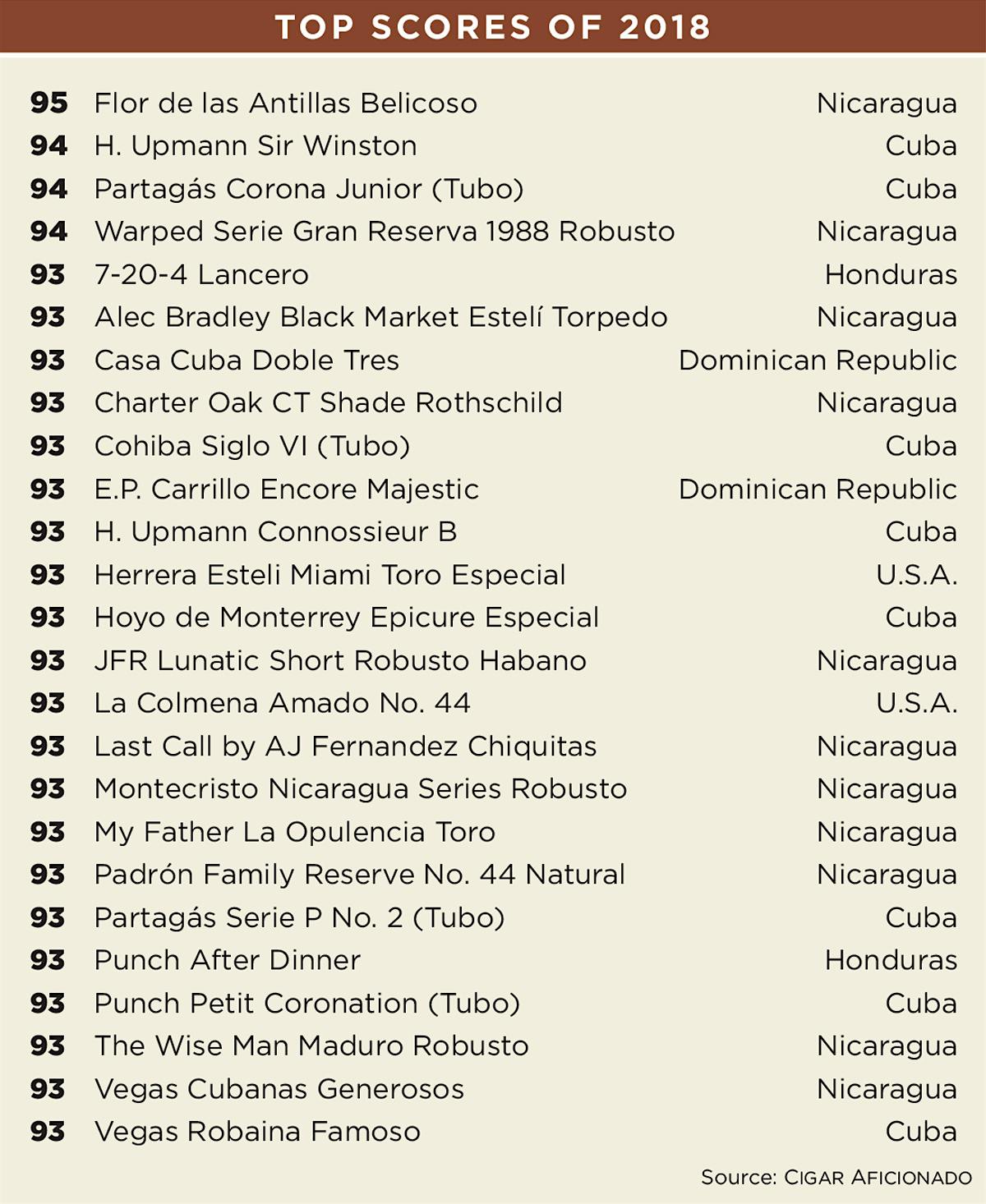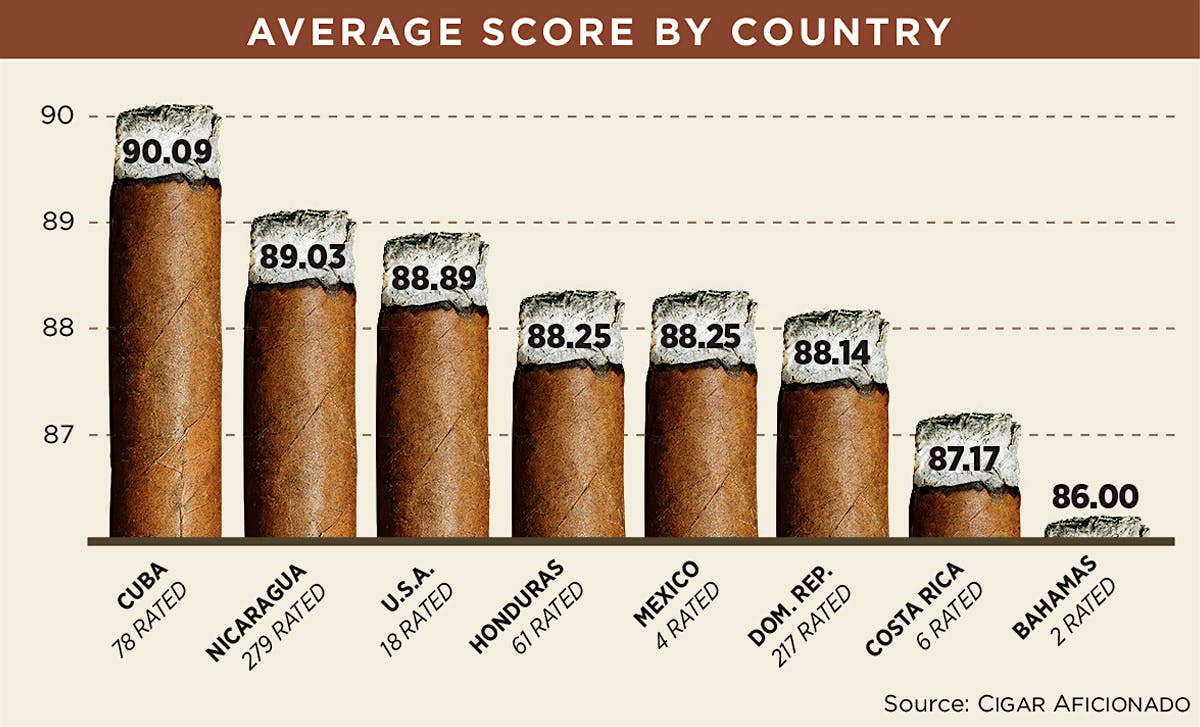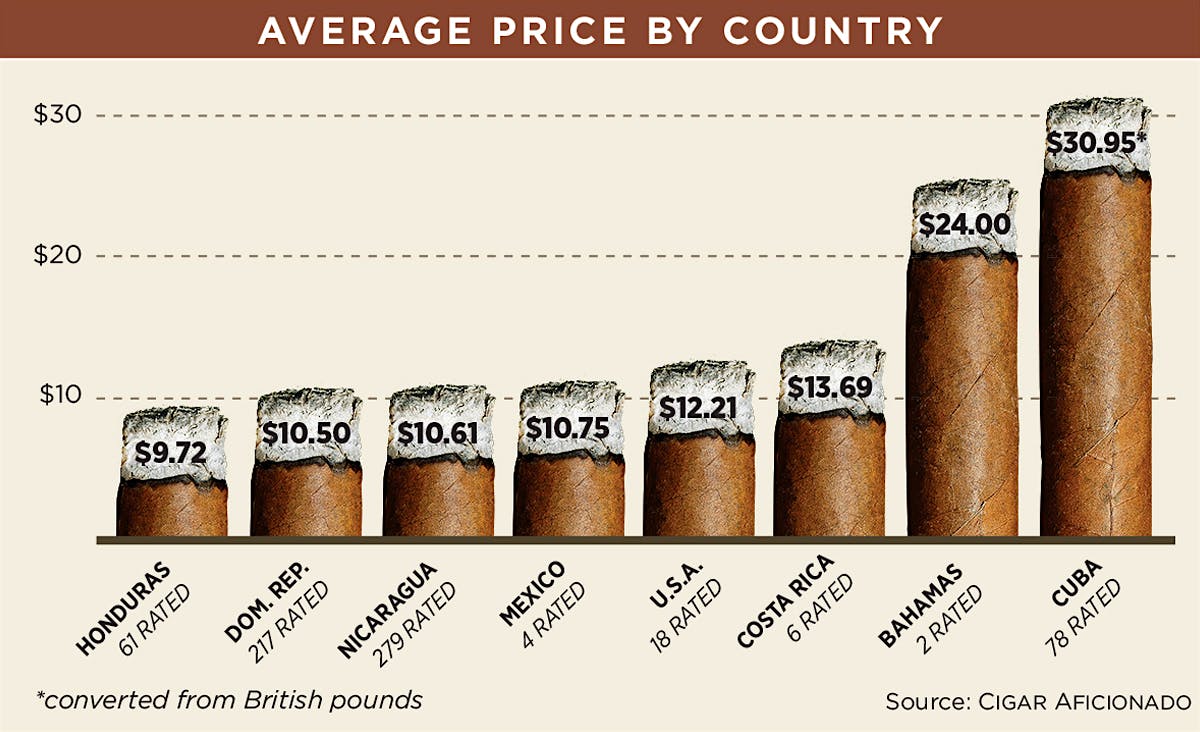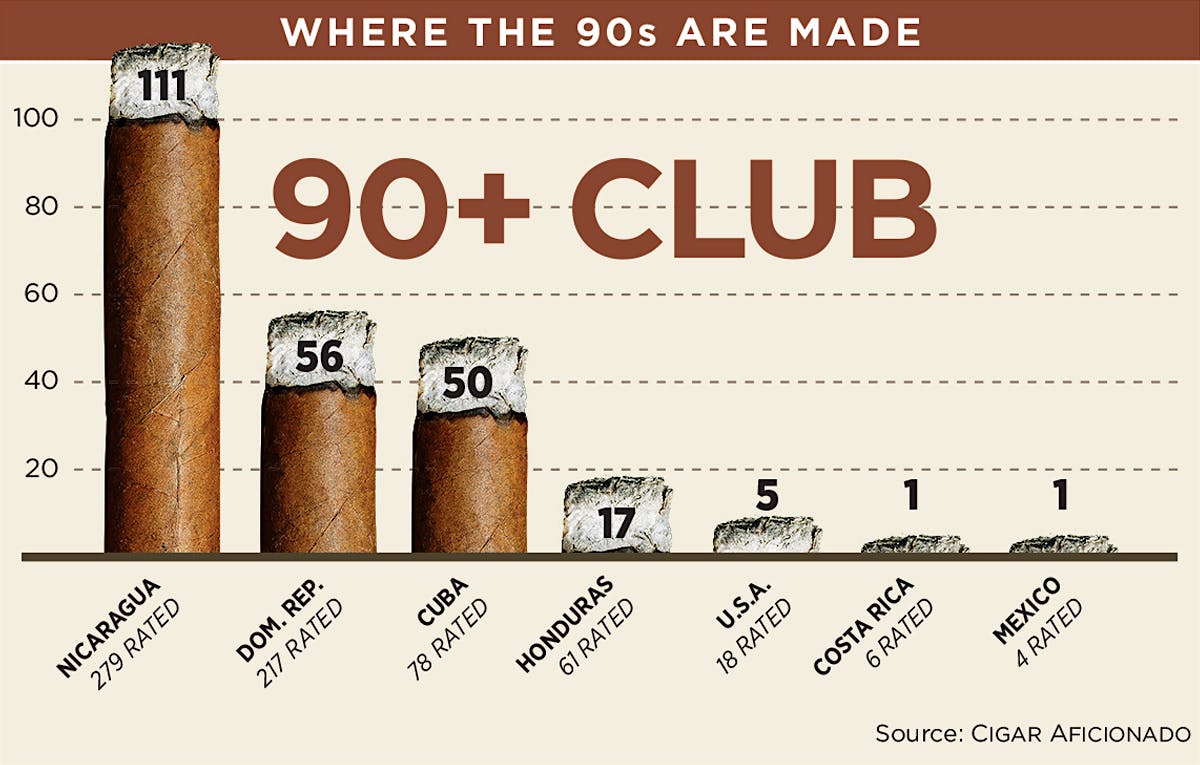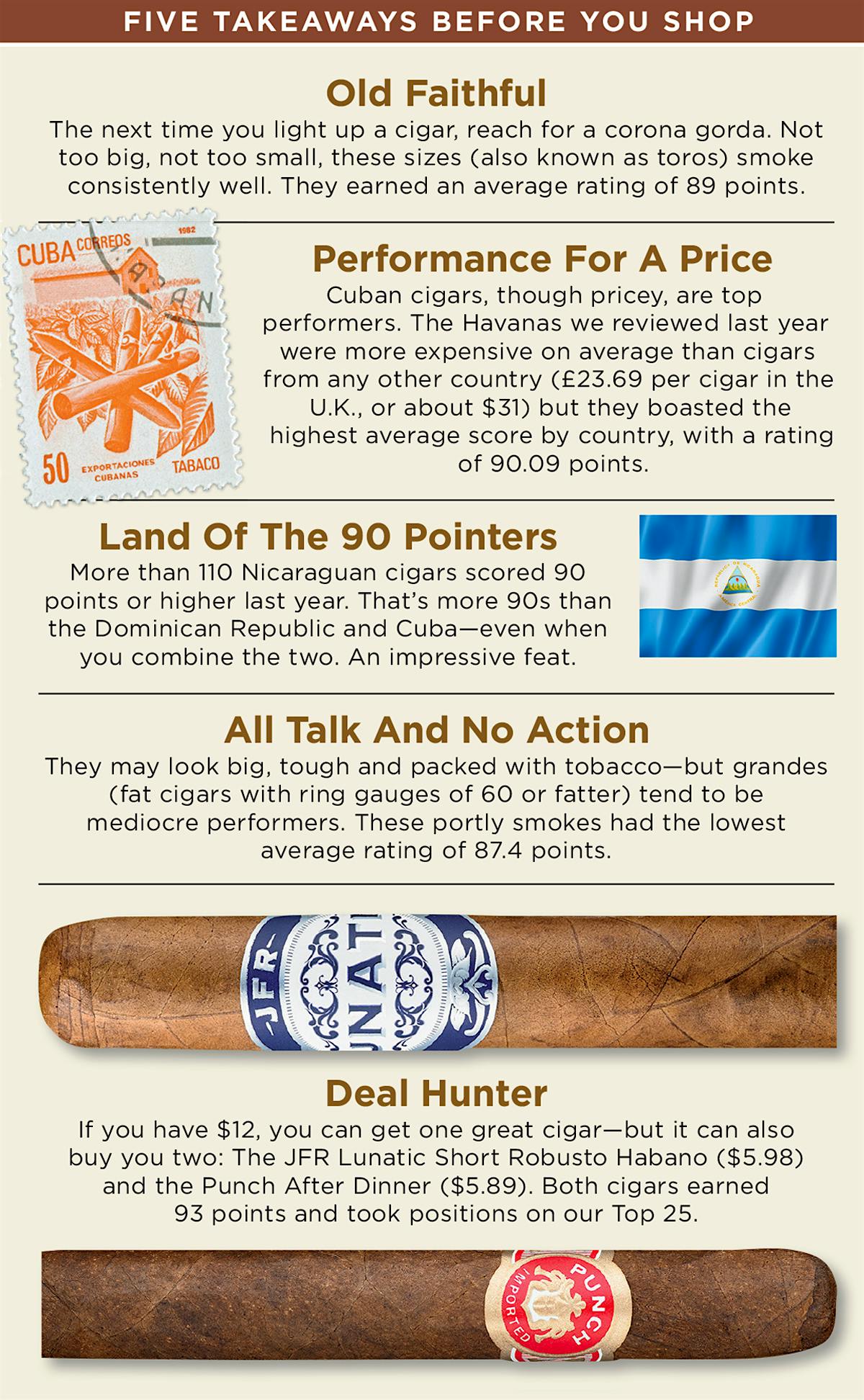2018 In Review

The phone rings in Cigar Aficionado’s New York office. An editor picks it up. It’s one of our readers with a question—well, a few questions, really. The caller wants to know:
“Which country makes the best cigars?”
“What size smokes better, a Churchill or a corona?”
“Are higher-priced cigars worth the extra money?”
We get the same questions in e-mails, too, and on our social media channels. Everybody wants to smoke the best cigars—we like to provide our readers with information and meaningful data to help them do so. One way we accomplish this is with our cigar ratings.
Cigar Aficionado magazine and its sister publication Cigar Insider rates hundreds of cigars each year in blind taste tests. These ratings keep cigar connoisseurs informed of what’s smoking well, and help consumers make better purchasing decisions at the cigar store. Collectively, a year’s worth of cigar ratings provides valuable insight into the cigar market as a whole. It gives us, and our readers, a good idea of what cigars truly are smoking best at this particular time.
We reviewed 665 different cigars last year. These smokes came from every major cigar-making country in all manner of shapes and sizes, presented to our tasting panel without any identifying bands. A tasting coordinator—who is not part of the tasting panel—strips the cigars of their bands and applies a generic white label with a numeric code to each cigar, so the members of the panel do not know the true identity of the cigars in the test. Only the coordinator knows the code.
This is the vital part of the blind tasting process, a procedure that removes any prejudice or brand familiarity a taster might have with a particular cigar. A cigar with a numeric code is judged solely on its merits: its appearance, how it smokes and most of all the quality of its tobacco.
By looking at a year’s worth of blind ratings together, we can rank the highest-scoring cigars of the year, determine the top-scoring cigar shapes and sizes and focus on what countries are producing the highest-rated smokes.
It’s important to note that of the 665 cigars we rated last year, 241 scored 90 points or higher. That’s about 36 percent, which speaks to the high quality of handrolled cigars currently available on the market. It’s a good time to be a premium cigar smoker, and this level of quality has remained consistent over the last few years: in 2017, 36 percent of cigars rated by our publications scored 90 points or higher. The year prior, 39 percent reached 90 points or above. Today’s consumer has high standards for their smokes, and they expect their cigars to exhibit a substantial degree of character and complexity. The market has responded to these demands with an exceptional amount of quality cigars.
Of the 241 cigars that scored 90 points or higher last year, 75 of them earned at least 92 points. From this elite subset, there were 25 cigars that scored 93 points or higher—not to be confused with the entries on our Top 25 Cigars of the Year list. Top 25 is a separate blind taste test, where the highest-scoring cigars of the year are pitted against one another. The winning cigars that emerge from the special bracket are deemed the Top 25 Cigars of the Year. If you look closely at the table below, you’ll notice many of the cigars that eventually made it onto the Top 25 started out here.
Let’s take a closer look at the high scores on this table. Last year, there were only four cigars that scored 94 points or higher. Two of them were rolled in Nicaragua and two of them were made in Cuba. One of the 94s was the Warped Serie Gran Reserva 1988 Robusto. The cigar was blended by Kyle Gellis, owner of Warped Cigars, who contracted the Aganorsa Leaf factory in Estelí, Nicaragua to create the cigar for him. The H. Upmann Sir Winston also scored 94 points. It’s a stately-looking Cuban cigar that’s named after Prime Minister Winston Churchill, and it went on to take the No. 5 spot on Cigar Aficionado’s Top 25 Cigars of 2018. The Partagás Corona Junior (Tubo) earned 94 points as well—it’s a slim Cuban petit corona that’s loaded with notes of leather, dried fruit and nougat.
There was only one cigar that scored higher than these three 94-pointers, taking the crown as highest scoring cigar of the year in a non-Top 25 taste test. The champion smoke was the Flor de las Antillas Belicoso, which earned 95 points—a classic rating on our 100-point scale. This attractive figurado impressed our panel with sophisticated notes of leather, marzipan and white chocolate before a toasty finish. The cigar is a puro, crafted only with Nicaraguan tobaccos, rolled at the My Father Cigars Factory in Estelí, Nicaragua.
Cigars that scored 92 points or higher last year came from all four major cigar-producing countries—Cuba, the Dominican Republic, Nicaragua and Honduras—but it’s clear the top scores were dominated predominantly by Nicaraguan-made cigars. Nicaragua has become one of the largest producers of handrolled cigars for the United States market, surpassing the Dominican Republic in premium cigar exports, according to the Cigar Association of America. And while the sheer quantity of Nicaraguan cigars on the market is immense, the quality has remained very high. Last year, we rated 279 cigars from Nicaragua. The average score of a Nicaraguan cigar was 89.03 points—one of the highest averages, second only to Cuban-made cigars. Nevertheless, Nicaragua is the only country that can boast over 100 ratings that were 90 points or higher last year.
Of the 279 Nicaraguan cigars we reviewed, a whopping 111 earned 90 points or higher. That’s nearly 40 percent. And if we take a look at the 11 Nicaraguan cigars that scored 93 points or higher, we can see that six of them went on to earn a spot on the Top 25. These include the My Father La Opulencia Toro, which took the No. 2 spot; The Wise Man Maduro Robusto (No. 3); the Padrón Family Reserve No. 44 (No. 4); the JFR Lunatic Short Robusto Habano (No. 7); the Alec Bradley Black Market Estelí Torpedo (No. 9); and the Montecristo Nicaragua Series Robusto, which landed the No. 10 position. The results are clear: Good things are coming out of Nicaragua.
Cuba also had a tremendous showing last year. We rated 78 Cuban cigars—and the average rating was 90.09—the highest of any cigar-making country. Of these 78 cigars, 50 scored 90 points or higher. That’s an impressive 64 percent, which demonstrates that Cuban cigars are smoking exceptionally well right now. Along with the 94-point Sir Winston and the Partagás Corona Junior there were five Cuban 93-pointers last year: Vegas Robaina Famoso, Punch Petit Coronation (Tubo), Partagás Serie P No. 2 (Tubo), the H. Upmann Connossieur B and Cohiba Siglo VI (Tubo). The Siglo VI ended up as No. 19 on the Top 25 list.
The Dominican Republic deserves high praise as well. It’s the second-largest exporter of premium, handrolled cigars to the U.S., and boasts its own considerable collection of high-scoring smokes. Last year, we rated 217 cigars from the Dominican Republic. The average rating of a Dominican-made cigar was 88.14. There were 56 Dominican cigars that earned 90 points or higher, roughly 26 percent of all Dominican cigars rated in 2018. Cigars leading the category include the Casa Cuba Doble Tres, a 93-pointer blended by the late Carlos Fuente Sr. before his passing in 2016. The Doble Tres is an elegant corona vitola rolled with an Ecuadoran Habano cover leaf.
Of course, there’s also the E.P. Carrillo Encore Majestic, blended by cigarmaker Ernesto Perez-Carrillo. Rolled in the Dominican Republic at Perez-Carrillo’s Tabacalera La Alianza factory, Encore is the company’s first cigar rolled only with Nicaraguan tobacco. It went on to take Cigar Aficionado’s highest accolade, the Cigar of the Year for 2018.
Honduras, often overshadowed by other cigarmaking countries, had its fair share of 90 pointers. Out of the 61 cigars we rated from Honduras, 17 cigars earned 90 points or higher, and the average score for cigars hailing from Honduras was 88.25. The country showcased its cigar rolling artistry with the 7-20-4 Lancero, created by cigarmaker Kurt Kendall, whose 7-20-4 brand is named after a long defunct New Hampshire–based cigar company from 1874. The Lancero, which scored 93 points, is rolled with a dark, Brazilian Mata Fina wrapper leaf and topped with a stubby pigtail cap. Honduras also brought us Punch After Dinner, a Churchill-sized cigar that scored 93 points and went on to secure the No. 12 position on our Top 25. Owned by General Cigar Co., Punch After Dinner is draped in a Connecticut broadleaf wrapper and delivers dense, chewy smoke that’s earthy and sweet.
Very few premium cigar brands are still rolled in the United States. Most handrolled cigars are produced overseas, where labor costs are cheaper. We rated only 18 cigars from the United States last year. Of that total, five scored 90 points or higher. The average score of a U.S.-made cigar was 88.89. Though our sample size was quite small, there’s still a case to be made that cigars rolled in the U.S. are of considerable quality. Take the La Colmena Amado No. 44, made by Warped Cigars and the Herrera Esteli Miami Toro Especial, by Drew Estate, for example. Both scored 93 points. The two brands are rolled at the El Titan de Bronze factory in Miami, Florida.
Cigars from our tastings also came from Mexico, the Bahamas and Costa Rica. These countries have very small premium cigar operations compared to the rest of the world. We rated less than seven cigars for each of these countries—with sample sizes this small, average scores are statistically insignificant.
Our ratings from last year also show that some cigar sizes smoke better than others. Cigar connoisseurs understand that the size and shape of a cigar can have a drastic effect on how it smokes. The same tobacco blend, rolled into five different cigar sizes, can reveal different flavor nuances and smoking characteristics based on its length and ring gauge proportions.
Of all the cigar sizes we rated last year, corona gordas, also commonly referred to as toros, were among the highest-scoring. Longer than a robusto and thicker than a corona, corona gordas capture an undeniable sweet spot between smaller and larger sizes. We rated 146 corona gordas last year, and the average score was 89.0 points. Churchills and lonsdales also performed well: both sizes tied with corona gordas for the same average. However, we rated far fewer of these cigars—only 95 Churchills, and just 29 lonsdales.
Coronas and figurados scored a bit lower, both sizes earning an average rating of 88.9 points. Coronas are becoming a rather obscure size—we only rated 31 last year, but figurados still enjoy immense popularity thanks to their eye-catching shapes. We define a figurado as a non-straight-sided cigar. Think belicosos, torpedos, Salomones or trompetas—any cigar with curves or tapers. We call these masterful creations figurados, and we rated 114 last year.
There was another tie, at 88.8 points, between double coronas and miscellaneous. Double coronas are extra-long cigars between 7 1/2 inches and 8 1/2 inches with a ring gauge of 49 or higher. They’re a dying size, unfortunately, and rarely found in cigar shops anymore. In today’s fast-paced world, most consumers don’t have the time to sit and enjoy a cigar that measures longer than a Churchill. On the opposite end of the spectrum we have miscellaneous cigars, which encompass all irregular length cigars that don’t fit into one of our traditional size categories—like the Cohiba Medio Siglo, which scored 90 points last year. At 4 inches long by 52 ring gauge, it’s too thick to be called a petit corona and a bit too short to fit into our robusto category. We rated 33 miscellaneous cigars last year.
Robustos, panetelas and petit coronas were among the lowest ranking sizes last year, with average scores of 88.7, 88.4 and 88.1, respectively. But none fared worse than grandes—oversized cigars measuring at least 6 inches by 60 ring gauge. These truly immense cigars are oddly popular among consumers, often due to the perception that a thicker cigar gives you more for your money.
However, jumbo-sized smokes might not be all they’re chalked up to be. We rated 38 grandes last year, and the average score was 87.4 points. Though frequently cited by retailers and cigarmakers as best-sellers, grandes, on average, were not the most impressive cigars in our blind tastings.
When it comes to purchasing a handrolled smoke, the common wisdom that “there’s a cigar for every person at every price point” holds true. Expensive cigars are not necessarily better cigars—you can find high-scoring smokes for less than $10. Take, for example, the JFR Lunatic Short Robusto Habano—it ended up earning the No. 7 spot on our Top 25 list and retails for $5.98 (before taxes).
If price is your main concern, Honduran cigars, on average, cost around $9.72, which is the lowest compared to any other country. Dominican, Nicaraguan and Mexican cigars all fall within the $10 range, at an average of $10.50, $10.61, $10.75, respectively. Cigars crafted in the United States tend to be a bit more expensive due to labor costs. The average price of a handrolled cigar in the U.S. was $12.21.
Costa Rica and the Bahamas produce some of the priciest cigars, with averages of $13.69 and $24, though these were very small sample sizes—we only rated six cigars from Costa Rica and two cigars from the Bahamas. Cuban cigars were by far the most expensive, with an average price of $30.95 per cigar (we converted the average price from British sterling pounds to U.S. dollars). We’re often asked, “Is it worth it to buy Cuban?” That’s for you to decide. But remember, of all our cigar ratings last year, Cubans earned an average score by country of 90.09, higher than any other cigarmaking country.
The data presented here is only meant to guide you. It doesn’t seek to change your mind or tell you what to buy. Numbers aside, a great cigar is not defined by its price or the country it’s made in—rather, it’s the experience you have while smoking it. Try new cigars and smoke what you like. Share them with friends. Those, after all, are the best cigars.
